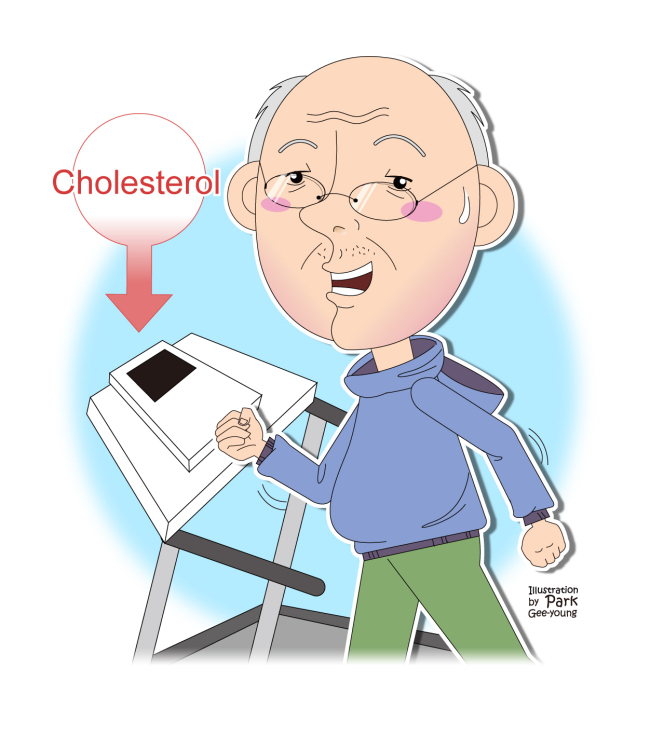
The recommended level of blood cholesterol is less than 200 milligrams per deciliter of cholesterol, less than 150 mg/dl of triglycerides, greater than 45 mg/dl of HDL cholesterol (prevents atherosclerosis) and less than 160 mg/dl of LDL cholesterol (causes atherosclerosis). Hyperlipidemia is defined by a total cholesterol of greater than 240 mg/dl and triglyceride of greater than 200 mg/dl.
Hyperlipidemia is an important factor that can cause atherosclerotic cardiovascular diseases such as angina, or chest pain; acute myocardial infarction, or heart attack; peripheral vascular disease, or the obstruction of arteries; and abdominal aortic aneurysm, the ballooning of the aorta. Having two to three risk factors for atherosclerotic cardiovascular disease increases the risk of disease by five-to 10-fold, so those who have other risk factors must put in extra effort to reduce blood lipid levels. In order to reduce blood lipid, one must exercise and have an appropriate diet. When this is insufficient, lipid-lowering medications should be considered.
Diet therapy
Cholesterol and triglycerides bind to apolipoproteins to form lipoproteins for transport in the blood. Lipoproteins are classified into high-density lipoproteins (HDL), low-density lipoproteins (LDL) and very low-density lipoproteins (VLDL). Cholesterol is mainly found in LDL and HDL cholesterol, whereas lipoproteins are mainly found in VLDL. Of all cholesterol, 20-30 percent are found as HDL.
A diet for those with hyperlipidemia consists of limited animal fats that are high in saturated fatty acids and cholesterol, which should be replaced with plant oils. Those who are obese must reduce the total caloric intake. In general, it is easier to reduce triglycerides in the blood than to reduce blood cholesterol. The effect of diet management can be seen after a few weeks; a drop of 19-58 mg/dl blood cholesterol and an approximately 50 percent reduction in triglycerides can be observed.
One egg (particularly the egg yolk) contains approximately 270 mg of cholesterol, and also contains high levels of saturated fatty acids, which can easily increase the levels of blood cholesterol. Other foods such as salted salmon roe, salted Pollack roe, squid, prawn, oysters, liver, organs of animals, brain and intestines also contain high levels of cholesterol. It helps to eat lots of blue back fish (e.g. mackerel, sardines) that contain high levels of EPA (eicosapentaenoic acid), cereals, beans (beans and green peas), vegetables and fruits. It is okay to eat lean meat. Remove the skin of the meat as it is high in cholesterol. Skinless chicken and pork is okay to eat.
Choose fat-free or skimmed milk, use margarine rather than butter, and eat low-fat cheese. Choose low-fat salad dressings, and reduce the intake of cream, cream-filled biscuits and foods made with cocoa milk.
Moderate amounts of alcohol intake is okay, but excessive intake can be a problem. There are reports that by actively reducing cholesterol levels, the lesions in the coronary arteries can be resolved. Better lipid-lowering agents are now available, and you should consult your doctor before using such medications. These medications can sometimes cause abnormal liver function or musculoskeletal enzyme disorders, so patients on these medications must have regular blood tests. Most of these medications are only effective while you are taking them, so it is best to put in the effort to exercise regularly and eat a good diet to improve lipid levels.

By Park Jeong-euy
The author is a doctor in the Division of Cardiology at Samsung Medical Center and a professor at Sungkyunkwan University School of Medicine. ― Ed.
The author is a doctor in the Division of Cardiology at Samsung Medical Center and a professor at Sungkyunkwan University School of Medicine. ― Ed.







![[Graphic News] More Koreans say they plan long-distance trips this year](http://res.heraldm.com/phpwas/restmb_idxmake.php?idx=644&simg=/content/image/2024/04/17/20240417050828_0.gif&u=)
![[KH Explains] Hyundai's full hybrid edge to pay off amid slow transition to pure EVs](http://res.heraldm.com/phpwas/restmb_idxmake.php?idx=644&simg=/content/image/2024/04/18/20240418050645_0.jpg&u=20240419100350)





![[From the Scene] Monks, Buddhists hail return of remains of Buddhas](http://res.heraldm.com/phpwas/restmb_idxmake.php?idx=652&simg=/content/image/2024/04/19/20240419050617_0.jpg&u=20240419175937)

![[KH Explains] Hyundai's full hybrid edge to pay off amid slow transition to pure EVs](http://res.heraldm.com/phpwas/restmb_idxmake.php?idx=652&simg=/content/image/2024/04/18/20240418050645_0.jpg&u=20240419100350)

![[Today’s K-pop] Illit drops debut single remix](http://res.heraldm.com/phpwas/restmb_idxmake.php?idx=642&simg=/content/image/2024/04/19/20240419050612_0.jpg&u=)